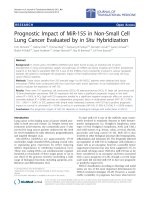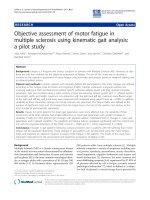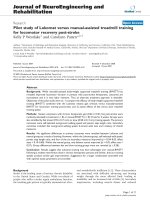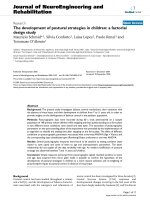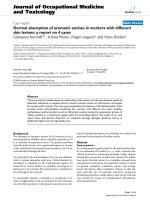Báo cáo hóa học: " Microscopic study of electrical properties of CrSi2 nanocrystals in silicon" potx
Bạn đang xem bản rút gọn của tài liệu. Xem và tải ngay bản đầy đủ của tài liệu tại đây (608.15 KB, 5 trang )
NANO REVIEW Open Access
Microscopic study of electrical properties of
CrSi
2
nanocrystals in silicon
László Dózsa
1*
, Štefan Lányi
2
, Vito Raineri
3
, Filippo Giannazzo
3
, Nikolay Gennadevich Galkin
4
Abstract
Semiconducting CrSi
2
nanocrystallites (NCs) were grown by reactive deposition epitaxy of Cr onto n-type silicon
and covered with a 50-nm epitaxial silicon cap. Two types of samples were investigated: in one of them, the NCs
were localized near the deposition depth, and in the other they migrated near the surface. The electrical
characteristics were investigated in Schottky junctions by current-voltage and capacitance-voltage measurements.
Atomic force microscopy (AFM), conductive AFM and scanning probe capacitance microscopy (SCM) were applied
to reveal morphology and local electrical properties. The scanning probe methods yielded specific information, and
tapping-mode AFM has shown up to 13-nm-high large-area protrusions not seen in the contact-mode AFM. The
electrical interaction of the vibrating scanning tip results in virtual deformation of the surface. SCM has revealed
NCs deep below the surface not seen by AFM. The electrically active probe yielded significantly better spatial
resolution than AFM. The conductive AFM measurements have shown that the Cr-related point defects near the
surface are responsible for the leakage of the macroscopic Schottky junctions, and also that NCs near the surface
are sensitive to the mechanical and electrical stress induced by the scanning probe.
Introduction
Chromium disilicide (CrSi
2
) i s a narrow band semicon-
ductor (E
g
= 0.35 eV [1]), which can be epitaxially
grown on Si ( 111) [2]. Strong increase of hole mobility
and decrease of hole concentration have been observed
in CrSi
2
epitaxial films on Si(111) [3] that corresponds
to considerable alterations in their band structure. In
previous studies of Cr d eposition on Si(111) the forma-
tion of self-organized semiconductor CrSi
2
islands has
been observed by differential optical spectroscopy (DOS)
andthethresholdfor3Dnanosizeislandformationhas
been determined [4]. The MBE growth of silicon cap
over the CrSi
2
islands was found to be optimal at 700°C,
with 50-nm Si cap thickness [4]. Under these conditions
silicon-silicide h eterostructures with CrSi
2
nanocrystal-
lites (NCs) have b een grown from 0.6-nm Cr deposited
onto 550°C silicon [4]. The electrical characteristics
were measured in 400 μm × 400 μm Schottky junctions.
Optical properties of the samples were studied in an
ultrahigh vacuum (UHV) chamber “ VARIAN” with a
base pressure of 2 × 10
-8
Pa equipped with AES and
DOS [5] facilities. A new migration mechanism of the
CrSi
2
NCs was found, the NCs are transferred through
nanopipes [6], which results in CrSi
2
NCs with different
depth distributions. Macroscopic Schottky junctions
include large number of NCs in dif ferent sizes a nd
depths, and therefore, to understand the behaviour of
the devices, the electrical parameters of single NCs are
needed.
In this study , CrSi
2
NCs, covered with 50-nm epi taxial
silicon but having different depth distributions, were
investigated. In order to improve the electrical charac-
terization of these nanostructures, the electrical para-
meters obtained by scanning probe tip are compared
with electrical charac teristics measured in macroscopic
Schottky devices.
Experimental
The CrSi
2
NCs and the silicon cap layer were grown in
UHV chamber without breaking the vacuum. Samples
were cut from n-type 7.5 Ωcm Si (111) substrates. The
silicon was cleaned by annealing at 700°C for 4-5 h,
cooling during 12 h, and cleaning flashes were applied
at 1250°C. Surface purity was controlled in situ by AES.
Cr was reactive epitaxy deposited on 550°C substrate
from a Tantalum tube. The Cr deposition rate was
* Correspondence:
1
Research Institute for Technical Physics and Materials Science, P. O. Box 49,
H-1525 Budapest, Hungary
Full list of author information is available at the end of the article
Dózsa et al. Nanoscale Research Letters 2011, 6:209
/>© 2011 Dózsa et al; l icensee Springer. This is an Open Acces s article distribute d under the terms of the Cre ative Comm ons At tribution
License ( which permits unrestricted use, distribution, and reproduction in any medium,
provide d the original work is properly cited.
about 0.02-0.04 nm/min controlled by a quartz sensor.
50 nm silicon cap was grown by MBE at 700°C at
deposition rate of 3-4 nm/min over the NCs.
The morphology was studied by atomic force micro-
scopy (AFM) in contact and tapping-mode. Conductive
AFM and scanning probe capacitance microscopy
(SCM) were measured in contact-mode using a Pt-
coated Si tip a nd a diamond-coated Si tip, respectively.
For the SPM characterisations a VEECO Dimension V
microscope was used.
Schottky junctions were prepared by evaporation of
400 μm × 400 μm square gold dots onto the silicon.
Gallium was scratched on the back side to form ohmic
contact. The depth distribution of the NCs was mea-
sured by transmission electron microscopy (XTEM)
using the sample preparation method described in [7].
Results and discussion
XTEM measurements have shown that the CrSi
2
NCs
migrate towards the surface during the cap growth [6,8].
The depth distribution of the NCs was different depend-
ing on the deposition rate. Two types of samples were
investigated. In one type, most of the NCs were seen by
XTEM near the deposition depth, while in the other
type they were observed mostly near the surface [6].
Electrical characteristics
Typical current-voltage (I-V) characteristics in Schottky
junctions of the two different types measured at 297 K
are shown in Figure 1a, and those measured at 77 K are
shown in Fig ure 1b. The series resistance dominates the
forward, and lea kage resistance dominates the reverse
I-V characteristics in samples where the NCs migrated
near the silicon surface. The typical le akage resistance is
about 1 kΩ at 297 K and increases to 56 kΩ at 77 K.
The cited resistance values are not related to the figures.
The figures demons trate the different types of I-Vs. The
leakage resistance is thermally activated, indicating that
the Fermi level in the cap is pinned by point defects at
about 160 meV from the conduction band. The thermal
activat ion of the leakage resistance was evaluate d by lin-
ear fits to the reverse I-V and by plotting the fitted
resistance values as a function of reciprocal temperature.
The capacitance-voltage (C-V) chara cteristics of the
junctions measured at room temperature are shown in
Figure 1c, and those measured at 77 K are shown in Fig-
ure 1d. Schottky junction capacitance 260 pF–indicated
asalineinFigure1c–corresponds to 50-nm depleted
layer thickness, equal to the nominal cap thickness.
Below -1 V reverse bias at low temperature, the doping
calculated from the 1/C
2
-voltage plot is appropriate
for the semiconductor substrate in both types of sam-
ples. The doping concentration p rofile was calculated
from the C-V characteristics measured at different
temperatures (not shown in the figures). The calculated
doping profiles in the two type of sampl es are shown in
Figure 2. The samples with NCs migrating near the sur-
face show high concentration of donors, while in sam-
ples with NCs remaining near 50-nm deposition depth,
the donor concentration is low.
DLTS characterization
The DLTS spectra were measured at -1 V reverse bias,
and 20 μs, 0 V filling pulses. The energy position of the
deep level calculated from the DLTS Arrhenius plot is
about 0.25 eV, appropriate for the Cr level at E
c
–0.27
eV in n-type silicon [9]. The large concentration of dop-
ing depicted in Figure 2 in samples where the NCs
migrated near the surface is explained by large concen-
tration of Cr-related point defects in the cap. In the
samples with NCs near the deposition depth, the low
donor concentration d epicted in Figure 2 is explained
by the low concentration of Cr-related deep-level
defects. The markedly different concentrations of Cr-
related point defect in the two types of samples indicate
that these defects may be related to the observed migra-
tion of the NCs during the cap growth. To enable us
understand t he role of the Cr-related defects in migra-
tion of NCs, we require further experiments.
AFM measurements
Tapping-mo de AFM amplitude and phase images of the
samples with NCs near the surface are shown in Figure
3a,b, respectively. The tapping-mode AFM amplitude
(Figure 3a) is not sensitive to t he CrSi
2
NCs. Several
bigger NCs appear in the phase image (Figure 3b). We
suppose that it is due to the electrical interaction of
NCs with the vibrating scanning tip. The phase of the
vibration changes, but does not cause energy dissipation,
interpreted as height in the amplitude i mage. Some
spherical protrusions appear with a diameter o f about
90 nm and a height of 12 nm in the amplitude. The
morphology measured in contact-mode does not show
these large protrusions. The difference can be an eff ect
of the pressure of the tip in contact-mode and the possi-
ble wear of the sample, since repeated scans over the
imaged areas has shown visible degradation of the sur-
face. However, we suppose that these protrusions are
mainly due to areas with large NC density in the cap,
resulting in virtual height increase in tapping-mode
amplitude image.
In samples with NCs 50 nm deep below the surface,
the morphology and the phase of the tapping-mode
AFM of the silicon surface measured are shown in Fig-
ure 4a,b, respectively. The NCs are hardly visible in
both amplitud e and phase images; the interaction of the
vibrating tip with NCs embedded 50 nm deep in silicon
is weak.
Dózsa et al. Nanoscale Research Letters 2011, 6:209
/>Page 2 of 5
Conductive AFM measurements
The sample with NCs close to the surface exhibited
large leakage at room temperature in macroscopic junc-
tions. To understand the reason of leakage this sample
was analysed by conductive AFM. The conductive tip is
scanned on the surface, and the current at a given vol-
tage is recorded and mapped. Conductive AFM reveals
the local conductivity differences in the vicinity of NCs.
Acr oss most of the surface, the current was nearly con-
stant and even independent of the polarity of the bias.
Locally, evidence of rectification could be observed. The
tip-wafer junction can be easily degraded by the local
current load, and so the reliability of repeated measure-
mentsusingotherbiasconditionsisquestionable.The
Figure 2 The apparent donor-concentration profiles in the two
types of samples calculated from C-V characteristics measured
at different temperatures.
Figure 1 Characteristics of the Schottky junctions on Si/CrSi
2
NC/Si structures: I-V measured at room temperature (a) and at 77 K (b); C-V
measured at room temperature (c) and at 77 K (d).
Figure 3 Tapping-mode AFM images of a 1 μm×1μmarea
on the sample with NCs below the 50-nm silicon cap: (a)
amplitude, (b) phase.
Dózsa et al. Nanoscale Research Letters 2011, 6:209
/>Page 3 of 5
results show that primarily the large concentration of
Cr-related point defect in this sample is responsible for
the leakage. The large local electric field around the
NCs may also act as local short-circuit path; however,
this kind of leakage was not strongly dependent on tem-
perature, as observed in large-area Schottky junctions.
SCM measurements
The contact-mode AFM amplitude and SCM images
recorded simultaneously in sample with redistributed NCs
are shown in Figure 5a,b, respectively. The SCM shows
definitely better contrast and spatial resolution than AFM,
indicating that the detection of NCs is improved when
electric al interaction is involved in the image. The size of
the observed objects is appropriate for NC sizes seen ear-
lier in XTEM and in AFM images [6,8].
The contact-mode AFM and SCM images of the sam-
ple with NCs at 50-nm depth are shown in Figure 6a,b,
respectively. The NCs are hardly visible in AFM, as the
sample surface is flat. The NCs are apparent in SCM.
The higher conductivity of inclusions increases the
locally sensed capacitance, and thus, the difference of
electrical properties of silicon and CrSi
2
gives a better
contrast for the detection of the NCs by scanning tip
capacitance sensing. NCs deep below the surface are
revealed in SCM images, and are not shown in the mor-
phology measured simultaneously. Deep NC features are
generally expected to appear somewhat smeared [10]. A
cross section of the SCM image across a NC is shown
in Figure 7. The half-width of the peak agrees with the
size of the NCs. It shows that the interaction of the
charged NC and the measuring tip is strong, which con-
trols the transport, and we assume that the measured
capacitance is dominated by the NC-host junction. The
measurements indicate that the NCs embedded deep–
having electrical characteristics different from the
defect-free host–can be detected using the SCM with
high resolution.
Conclusions
Electrical characteristics of monolithic Si/CrSi
2
NCs/Si
structures with different depth distributions of the NCs
were investigated in large-area Schottky junctions by I-V
and C-V measurements, and locally by scanning probe
techniques, conductive AFM and SCM. It is shown that
the CrSi
2
NCs in 50-nm depth in a defect-free silicon
matrix can be detected by elec trically active probes with
a resolution comparable to the NC size, and that the
SCM gives better contrast and spatial resolution than
the tapping-mode AFM. We suppose that this is because
the charged NCs control the electric transport. It shows
that in appropriate host crystal, SCM may reveal the
Figure 4 Tapping-mode images of a 1 μm×1μm area on the
sample with NCs near the surface. (a) amplitude, (b) phase.
Figure 5 Contact-mode scanning probe images of a 1 μm×1
μm area on the sample with NCs near the surface. (a). AFM
amplitude image. (b). SCM image of the same area.
Figure 6 Contact-mode scanning probe images of a 1 μm×1
μm area on the samples with NCs 50 nm below the surface.
(a). AFM amplitude image. (b). SCM image of the same area.
Figure 7 An SCM line profile across a NC 50 nm below the
surface.
Dózsa et al. Nanoscale Research Letters 2011, 6:209
/>Page 4 of 5
individual NC-host junction properties. Tapping-mode
AFM image is distorted by the interaction of the NCs
with the vibrating tip. It is shown that high concentra-
tion of Cr-related defects induces leakage in large area
Schottky junctions. The results show that the measuring
tip-wafer current may seriously degrade the devices with
NCs near the surface.
Abbreviations
AFM: atomic force microscopy; DOS: differential optical spectroscopy; NCs:
nanocrystallites; SCM: scanning probe capacitance microscopy; UHV:
ultrahigh vacuum; XTEM: transmission electron microscopy.
Acknowledgements
This study was financially supported by the FEB RAS grants No 10-02-00284-
a, by the OTKA grants (Hungary) No. K81998 and K75735, the Program
between the Russian Academy of Sciences and the Hungarian Academy of
Sciences (2005-2007, project No 22), by the SK-HU-0024-08 project of
Slovakian-Hungarian and SK-IT-0020-08 project of Slovakian-Italian scientific
cooperation agreements.
Author details
1
Research Institute for Technical Physics and Materials Science, P. O. Box 49,
H-1525 Budapest, Hungary
2
Institute of Physics of the Slovakian Academy of
Sciences, Dúbravská Cesta 9, SK-854 11 Bratislava, Slovakia
3
CNR-IMM, Strada
VIII 5, 95121Catania, Italy
4
Institute for Automation and Control Processes of
Far Eastern Branch of Russian Academy of Sciences, 690041 Vladivostok
Radio 5, Russia
Authors’ contributions
LD designed the study, carried out the electrical measurements on Schottky
junctions, and drafted the manuscript, SL, VR, and FG measured the
scanning probe measurements, NG has prepared the samples. All authors
read and approved the final manuscript.
Competing interests
The authors declare that they have no competing interests.
Received: 30 September 2010 Accepted: 9 March 2011
Published: 9 March 2011
References
1. Borisenko VE, (Ed): Semiconducting Silicides Berlin: Springer Verlag; 2000, 480.
2. Wetzel P, Pirri C, Peruchetti JC, Bolmont D, Gewinner G: EPITAXIAL-
GROWTH OF CRSI AND CRSI2 ON SI(111). Solid State Commun 1988,
65:1217.
3. Galkin NG, Velitchko TV, Skripka SV, Khrustalev AB: Semiconducting and
structural properties of CrSi2 A-type epitaxial films on Si(111). Thin Solid
Films 1996, 280:211.
4. Galkin NG, Goroshko DL, Dotsenko SA, Turchin TV: Self-organization of
CrSi2 nanoislands on Si(111) and growth of monocrystalline silicon with
buried multilayers of CrSi2 nanocrystallites. J Nanosci Nanotechnol 2008,
8:557.
5. Dotsenko SA, Galkin NG, Gouralnik AS, Koval LV: In situ differential
reflectance spectroscopy study of Fe-Si(111) and iron silicide - Si(111)
interfaces e J Surf Sci Nanotechnol 2005, 3:113.
6. Galkin NG, Dózsa L, Chusovitin EA, Pécz B, Dobos L: Migration of CrSi2
nanocrystals through nanopipes in the silicon cap. Appl Surf Sci 2010,
256:7331.
7. Barna A, Pécz B, Menyhard M: Amorphisation and surface morphology
development at low-energy ion milling. Ultramicroscopy 1998, 70:161.
8. Galkin NG, Dózsa L, Turchin TV, Goroshko DL, Pécz B, Tóth L, Dobos L,
Khanh NQ, Cherednichenko AI: Properties of CrSi2 nanocrystallites grown
in silicon matrix. Phys Condensed Matter 2007, 19:506204.
9. Mishra K: Identification of Cr in p-type silicon using the minority carrier
lifetime measurement by the surface photovoltage method. Appl Phys
Lett 1996, 68:3281.
10. Lányi Š, Hruškovic M: The resolution limit of scanning capacitance
microscopes. J Phys D Appl Phys 2003, 36:598.
doi:10.1186/1556-276X-6-209
Cite this article as: Dózsa et al.: Microscopic study of electrical
properties of CrSi
2
nanocrystals in silicon. Nanoscale Research Letters 2011
6:209.
Submit your manuscript to a
journal and benefi t from:
7 Convenient online submission
7 Rigorous peer review
7 Immediate publication on acceptance
7 Open access: articles freely available online
7 High visibility within the fi eld
7 Retaining the copyright to your article
Submit your next manuscript at 7 springeropen.com
Dózsa et al. Nanoscale Research Letters 2011, 6:209
/>Page 5 of 5


